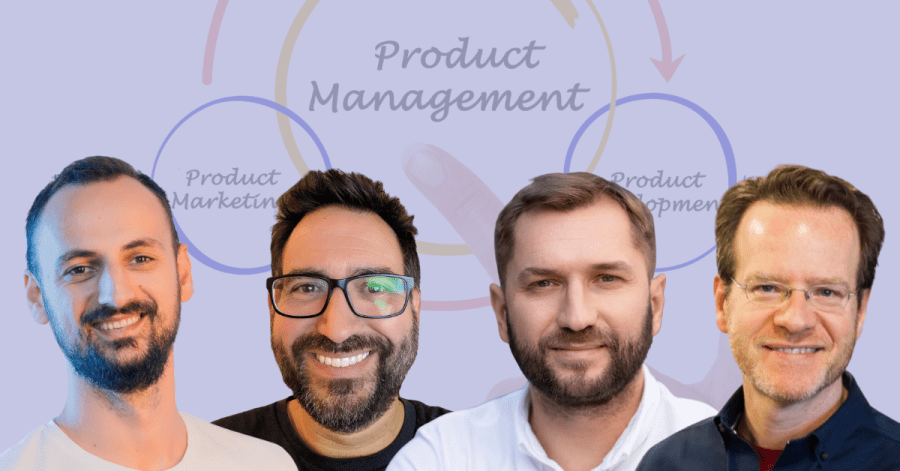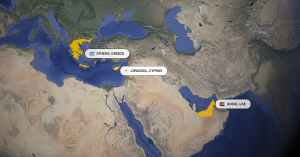How can product leaders overcome some of the biggest challenges they face these days? What is the secret to a successful product-led strategy? And how can a product leader stay sharp?
Thanks to the latest edition of How to Web, I got to hear first-hand lots of practical advice from seasoned product people for their fellow professionals – and I couldn’t help wanting to pass it on.
To unearth more wisdom for product teams, I followed up with four of the speakers on the Product stage:
• Bruce McCarthy, author, speaker, and Founder at US-based Product Culture, a consulting company for product development; he has led product teams in organizations ranging from startups like NetProspex to market leaders such as ATG, Oracle and D&B;
• Robert Katai, Product Marketing Manager at Creatopy, a Romanian ad production platform built in Transylvania that currently counts 4 million users; he is an experienced marketing professional and a successful content creator;
• James Mayes, Co-Founder of US-based Mind The Product, one of the largest communities of Product Managers, exited to Pendo; currently, he is an evangelist at Pendo, and previously he spent over a decade building high performance tech teams;
• Liviu Herman, Chief Product Officer at Tazz, a fast-delivery company and spinoff of Romanian eCommerce leader eMag; he has a total of 8 years of experience in project management and product management.
The Recursive: What is a challenge that you see product leaders face and how can they overcome it?
A frequent challenge experts have encountered is creating alignment and connecting the dots among product teams, managers and marketers alike, as well as in the wider organization. At a macro level, product teams are navigating the same stormy waters across most sectors, facing challenges such as economic uncertainty and a war for talent. Sometimes, the best talent can be found in unexpected places.
Bruce McCarthy, Product Culture: The biggest challenge I see for product leaders today is creating visibility and alignment around the organization for the product vision, the product strategy, and the roadmap. It’s no use having the perfect plan or strategy if nobody knows about it, if nobody is bought into it, and if not everyone is going to follow it.
Robert Katai, Creatopy: It doesn’t matter if you are a product manager or a product marketer – there is one big challenge I think many will face one day: to connect the right dots. Because we as marketers like to find out new possibilities to get the product in front of an audience but product managers want to ship it when it’s ready. So there is a tension between perfection and progress. That’s why connecting the dots is a back-in-the-mind tension that will always be there. How to overcome it? There is not a simple job-to-be-done solution here. It’s a lifestyle you need to live with and use to make yourself and your work better
James Mayes, Mind the Product: Many product leaders struggle with finding talented junior product managers they can develop into the product teams of the future. One excellent tactic here is to ask the engineering team who they know by name on the customer support or success team. If the engineers know someone on that team, you’ve found a customer-focused person who cares enough about the problem to go harass engineers, and isn’t afraid to deal with engineering teams. That’s a great starting set of attributes for a junior PM.
Liviu Herman, Tazz: In present times, the biggest challenge that I see for product people is the high uncertainty in all the major market fields. Even the ones that were really stable in the past are now a lot more susceptible to influence factors that are only tangent to the target domain.
This means that, in order to be prepared, the product leader should think in advance in scenarios, having a product roadmap that is much more flexible and responsive to outside factors.
What is one key pillar of a product-led strategy that can lead to an outsized impact?
While it’s impossible to explain all the core elements of a product-led strategy in an article, product experts pinpointed ones that stood out for them. Managers should think of their product teams as broadly as possible, taking into account all tangential functions, and onboarding people in the planning process early on. Then, one needs to take advantage of the power of data analytics to identify actual product challenges for the users, as well as to break growth strategies into small, measurable steps. Finally, don’t be afraid to look where no one else is looking and dare what no one else is daring to try.
Bruce McCarthy: Most of the teams I work with are pretty good at doing the basics of product management. They can do the discovery, research, problem solving, prioritization, sprint planning, and release planning – all of the hard science parts of product management.
But the thing that really makes a difference between doing a good job at product management and having an effective product strategy is alignment. To have an impact, a product strategy needs to have consistent alignment throughout the organization in engineering and you ask, of course, but also in sales and marketing and finance, even legal.
I advise product leaders to think of the product team much more broadly, as containing all of these different functions at least as part-time members of the team. When you treat them like members of the team and you bring them into your planning process early, then they are part of your planning. They help you make better decisions that are easier to implement across the organization, and that stick throughout the life of a product. This aligns all of the different parts of the organization – not just during the development – but also during the launch and the life in market of the product. Alignment makes for the greatest impact.
Robert Katai: I love what Ryan Holiday said – “Do the work nobody wants to do”. It’s not a product-led strategy, it’s more as a lifestyle you can use in a product-led strategy. Just look at products like Notion, Miro, Figma and others who have had this amazing impact in the ecosystem. Nobody wanted to do another Apple Notes or Evernote product, but Notion did it. Nobody wanted to do another Adobe Sketch product, but Figma did it. And they impacted the world using a simple strategy: community builders.
If you want a key pillar to your product-led strategy, start with the “Do the work nobody wants to do” mindset and sprinkle it with the community builder strategy.
James Mayes: One key pillar of a product-led strategy would be the extensive use of data – gathering analytics on all usage aspects of the product, and using that to inform faster and more accurate decision making, inform roadmap decisions, define where user guides might be best placed to drive adoption and great customer outcomes.
Liviu Herman: I think that an important pillar in a product-led strategy would be an incremental combination between product development and market penetration. This would mean that splitting the growth strategy in small, measurable steps would simultaneously validate the product added value and the market appetite; this could also bring small intermediate income sources.
How do you build a bridge between product thinking and business building in a tech company?
The success of a company depends on an integrated approach to product and business. From the very start, product planning needs to be done with business considerations in mind. As the product and business evolve, constant communication between cross-functional teams is crucial. A product leader, particularly, needs to develop and maintain a commercial and financial awareness of the business in as much detail as possible.
Bruce McCarthy: When your team is fully cross-functional, the considerations of business are built into the product planning from the beginning. This is the simplest way to ensure that a gap between business and product never occurs.
This is a big job, not always easy to accomplish. Product leaders may need to spend up to a third of their time on aligning with cross-functional teammates and other stakeholders all around the organization.
Robert Katai: By over communicating and over collaborating. At Creatopy, we are communicating constantly every time we need to make a feature from our product better. There is powerful communication between departments because we understand that we can’t be single wolves in this marathon. The product department needs the marketing department. The sales department needs the design department. The support department needs the product department. And we intersect every day in different calls, meetings and just talking about what we are working at, what we want to achieve and what steps we want to take. For example, every time I work on a message and a position I love to have a discussion with some of the members from our design team. They are like lighthouses for me.
James Mayes: To build the bridge between product building and business building, a lot starts with the product leaders developing a great commercial awareness of how the business functions financially. The change is happening, but still too many PM’s don’t understand the cost of customer acquisition metrics or the cost of servicing support tickets. Without understanding these financial elements, it’s harder for prioritization to go beyond simply the customer or exec who’s shouting loudest!
Liviu Herman: If one is thinking about building bridges between product thinking and business building in tech companies, it is too late. This integrated approach of product and business should be one of the core values of the company, from the day that the company founders had the idea of a new business and transmitted organically in the organization until it’s part of its culture.
The digital product cannot exist outside of the business value spectrum and, on the other side, if the business revenue streams are totally independent of the digital products developed, then it’s not a tech company anymore.
What tools and learning sources would you recommend to a product leader?
According to experts, books, articles, and podcasts are first-hand learning resources, but they should also be complemented with lots of interaction and collaboration with other people, both in real life and on social media. In the end, there is no better way to learn a topic than having to write or talk about it. And you shouldn’t restrict yourself to product-related content to grow as a product leader: having a good understanding of the overall business, the market, as well as market forces, is just as important.
Bruce McCarthy: Find your local product community wherever you happen to be, whether it’s a ProductTank or a ProductCamp or, for example, in the Boston area we have the Boston Product Management Association (BPMA). Those folks usually have regular meetups where you can connect with like-minded product people who will share their experience and with local experts who do talks and workshops.
I can also recommend my book, Product Roadmaps Relaunched, and the new book I’m working on, Aligned: Stakeholder Management for Product Leaders, due out next summer from O’Reilly. And I have a weekly ‘nano-letter’. I call it that because it’s so short it’s actually quicker to read it then to put it in your read later folder that you never get around to reading. I use this nano-letter, ONE THING on Product Culture, to point people at the latest information and resources on the practice of product leadership. You can find out more on Product Culture.
Robert Katai: The best tool and learning source a product leader can have is starting a Linkedin and Twitter account, find out what they like to talk about and share their ideas about and start creating content every single day for the next 3 years. Every single day I take around 1 hour to create content and connect with other product leaders. Talk about your struggles in the product area, talk about your wins and your questions. Share your findings, insights and communicate. Don’t just reshare links and others’ opinions. Make your own and stand for them. Connect with others and come up with your own ideas. This way you will learn more than through any single article, podcast, or YouTube video.
James Mayes: For tools and learning, I’d simply point to Mind the Product – we’ve spent a decade gathering and polishing amazing product stories from around the world. What challenges people faced, what tools they used, which mistakes they’ve made and what they learned. It’s an amazing resource for any product professional.
Liviu Herman: There are so many valuable books, articles, talks available online and offline, so many inspiring product professionals with which people can interact, that I find mentioning them redundant and maybe unfair.
A great product leader is one that knows a lot more than product management (most of the rules follow the same major guidelines with various adaptations). But in order to be successful, it is important to have a very deep understanding of the business that the company is in. And I mean deep, much more than just the interactions with the product itself.
Going further, I would say that following the T-shaped skills development model, I would put on the vertical line getting to know and getting to like your business with all its aspects and, on the horizontal line, general information, being up to date with what is happening not only in the business, but in all the fields that are marginal to the business itself, and, more than this, with what is happening in the world.
The next good decision might very well come not from knowing good product management theory or from a tool, but from knowledge of what’s happening closer or further from the desk that one is working at.








